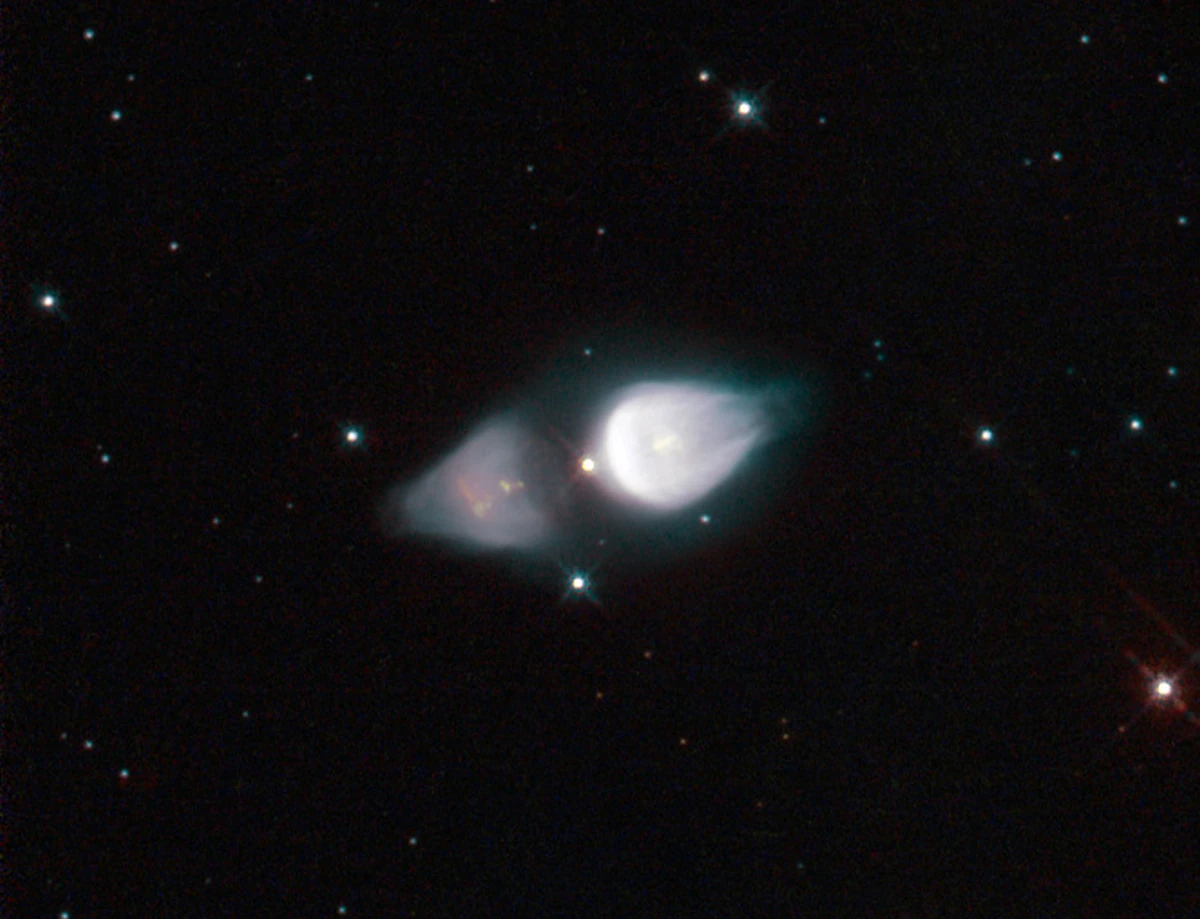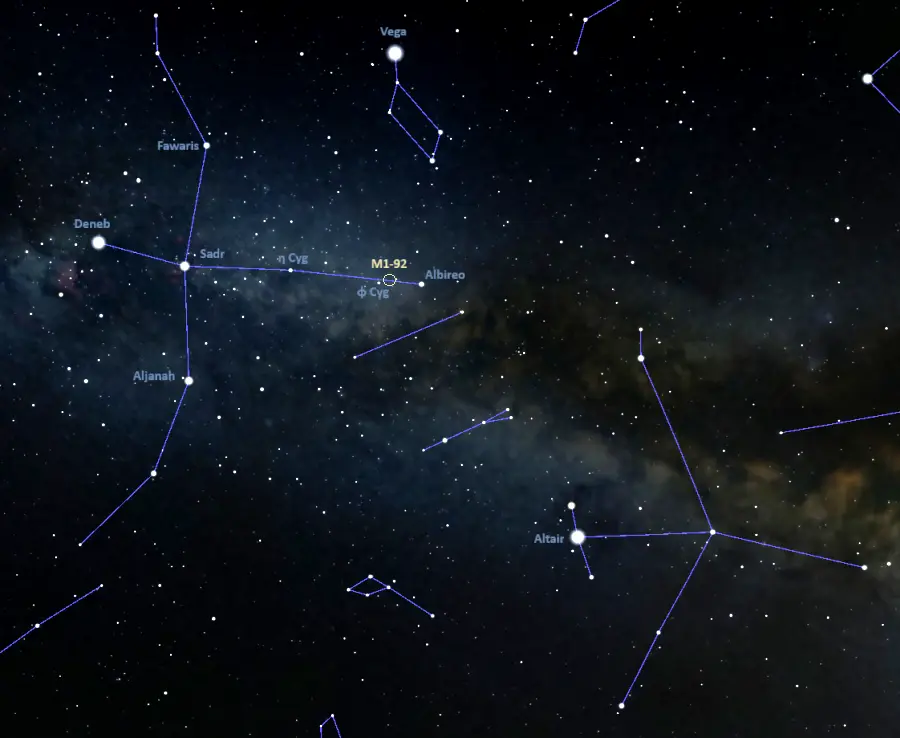The Footprint Nebula (Minkowski’s Footprint) is a bipolar protoplanetary nebula located approximately 8,000 light-years away in the northern constellation of Cygnus. It has an apparent magnitude of 11.7 and an apparent size of 8 by 16 arcseconds. It is catalogued as Minkowski 92 (M1-92).
The protoplanetary nebula has a prominent pair of onion-shaped lobes extending on either side of the nebula’s central star. The lobes are roughly symmetrical and diametrically opposed. They are separated by a dark lane that partly obscures the nebula’s central star.
The central star is evolving into a white dwarf, but it is not yet hot enough to ionize the surrounding nebula. In a few thousand years, when it reaches sufficiently high temperatures to emit enough ultraviolet radiation to make the nebular material emit its own light, the cosmic Footprint will become a planetary nebula. Now it is still a reflection nebula. It only reflects the light of the central star.

The NASA/ESA Hubble Space Telescope has been used to capture a striking image of a rare astronomical phenomenon called a protoplanetary nebula. This particular example, called Minkowski’s Footprint, also known as Minkowski 92, features two vast onion-shaped structures either side of an ageing star, giving it a very distinctive shape. Protoplanetary nebulae like Minkowski’s Footprint have short lives, being a preliminary stage to the more common planetary nebula phase. In the middle of the image is a star, soon to be a white dwarf, puffing out material due to intense surface pulsations. Charged particle streams, called stellar winds, are shaping this gas into the interesting shapes that Hubble allows us to see. Technically speaking Minkowski’s Footprint is currently a reflection nebula as it is only visible due to the light reflected from the central star. In a few thousand years the star will get hotter and its ultraviolet radiation will light up the surrounding gas from within, causing it to glow. At this point it will have become a fully fledged planetary nebula. The processes behind protoplanetary nebulae are not completely understood, making observations such as this even more important. Hubble has already conducted sterling work in this field, and is set to continue. The image was obtained with the Hubble’s Wide Field Planetary Camera 2. The picture has been made from many exposures through four different colour filters. Light from ionised oxygen has been coloured blue (F502N), light passing through a green/yellow filter (F547M) is coloured cyan, light from atomic oxygen is coloured yellow (F631N) and light from ionised sulphur is coloured red (F673N). The total exposure times per filter were 2080 s, 960 s, 2080 s and 1980 s respectively and the field of view is only about 36 arcseconds across. Image credit: ESA/Hubble & NASA (CC BY 3.0)
The Footprint Nebula has a kinematical age of 1,200 years. It is composed of material expelled by the central star as it reached the end of its life. The ejected material resembles the shape of a human footprint. The northwestern lobe of M1-92 forms the sole of the foot while the smaller and fainter southeastern lobe outlines the heel. The southeastern lobe appears dimmer because it is partly obscured by dust.
As it bursts through the ends of the bipolar lobes, the hot polar outflow of expelled material produces two polar tips. The tips have an estimated temperature of around 450 K. The lobes are much cooler at 17 K. The line emission in the lobes is dominated by shock emission.
The lobes contain bright ionized knots that speed through the gaseous clouds at 55 km/s. The narrow jet of ionized matter that emanates from the central star has a slightly different axis from the lobes.
The Footprint Nebula was imaged by the Hubble Space Telescope (HST) in 1996. The Hubble images revealed that the shock-heated gas was concentrated in diffuse knots in the lobes. The data obtained with HST demonstrated that the shock emission was produced by the collimated outflow that originated near the nebula’s central star.
Protoplanetary nebulae are a brief stage in the evolution of Sun-like stars that follows the late asymptotic giant branch (LAGB) phase. During the LAGB phase, stars experience strong mass loss, and their outer envelopes become highly disrupted, to the point where no significant mass loss is likely to occur anymore. This marks the beginning of the preplanetary nebula phase.
At this point, the temperature of the central star is around 5,000 K, which is not enough to ionize the circumstellar shell of expelled material. However, the star’s high-velocity winds shock and carve shapes in the slow-moving ejecta, producing the morphology of what will next become a planetary nebula.
When the temperature of the central star reaches 30,000 K, the star becomes hot enough to excite the circumstellar nebula. At this point, the nebula becomes an emission nebula, i.e. a fully fledged planetary nebula.
The central star of the Footprint Nebula has an estimated temperature of 27,000 K. It has the spectral type B0.5 IV. It may be a binary system. Researchers have identified a star of the spectral type F5 as a possible companion, but the binary nature of the central source is still uncertain.
Astronomers have proposed that Minkowski 92 may be similar to the symbiotic star MWC 560 in the constellation Monoceros, composed of a red giant and a white dwarf. Both M1-92 and MWC 560 have thick equatorial disks of dust and collimated jets, and they have similar spectra. However, MWC 560 has not expelled its gaseous envelope yet and is thought to be in an earlier phase of its evolutionary cycle.
A 2024 study led by Elisa Masa, Observatorio Astronómico Nacional (IGN), Madrid, Spain, proposed that the central star of M1-92 may still be expelling material. The astronomers suggested that the nebula was produced from a sudden massive ejection event that interrupted the star’s evolution on the thermally pulsing AGB phase, preventing its transformation into a carbon-rich star. The huge mass-loss event amounted to around 0.9 solar masses of material lost in less than 100 years, and it produced the present nebula.

The Footprint Nebula (M1-92), image credit: Jusy Schmidt (CC BY 2.0)
Facts
The Footprint Nebula was discovered by the German-American astronomer Rudolph Minkowski in 1946. Minkowski found the nebula after analysing photographic plates taken by W. C. Miller using the 10-inch telescope at Mount Wilson Observatory. He later examined the object on plates obtained with the 60-inch or 100-inch telescope at Mount Wilson and identified it as a planetary nebula. He described the object as a “binuclear nebula without central star,” adding that, “The nebula is probably not an emission nebula, but a reflexion nebula which obscures the peculiar star by which it is illuminated.” Minkowski published his discoveries in The Astronomical Society of the Pacific, No. 344, in 1946.
Minkowski’s other discoveries include the Eye of Sauron Nebula (M1-42) in the constellation Sagittarius, M1-63 in Scutum, Hen 2-437 in Vulpecula, and the Twin Jet Nebula (Minkowski’s Butterfly, M2-9) in Ophiuchus.
The Footprint Nebula was imaged by the Very Large Array (VLA) in 1983. A 1991 study by E. R. Seaquist and René Plume, Department of Astronomy, University of Toronto, and L. E. Davis, National Optical Astronomy Observatories (NOAO), Arizona, found that the hydroxide (OH) emission in the nebula originated in the circumstellar gas disk with an axis that coincided with that of the nebula’s lobes. However, no OH emission was detected in the lobes themselves. The astronomers found a radial expansion velocity of 18 km s-1 for the emission.
Minkowski’s Footprint Nebula is one of the several known protoplanetary nebulae in Cygnus. Others include the Egg Nebula (RAFGL 2688) in the region of the Swan’s wings, IRAS 20068+4051 near Sadr (Gamma Cygni), and IRAS 19475+3119 in the area between Eta Cygni and Albireo (Beta Cygni).
Minkowski 92 is not to be mistaken for the Fossil Footprint Nebula (NGC 1491), an emission nebula in the constellation Perseus.
Location
The Footprint Nebula appears in the region of the celestial Swan’s head, near the bright Albireo, the star that marks the Swan’s beak. It lies along the imaginary line connecting Albireo and Eta Cygni, near the binary yellow giant Phi Cygni (mag. 4.7).
Albireo is easy to identify because it is part of the Northern Cross, a prominent asterism that dominates the constellation Cygnus. The asterism is formed by the bright Deneb with Albireo, Aljanah, Fawaris and Sadr. Phi Cygni is the brightest point of light between Albireo and Eta Cygni, which lies between Albireo and the brighter Sadr.
At declination +29° 33′, the Footprint Nebula is visible from locations north of the latitude 60° S, i. e. from any inhabited location on Earth.
The best time of the year to observe M1-92 and other deep sky objects in Cygnus is during the month of September, when the constellation dominates the early evening sky.

Location of the Footprint Nebula (M1-92), image: Stellarium
Footprint Nebula – M1-92
| Constellation | Cygnus |
| Object type | Protoplanetary nebula |
| Right ascension | 19h 36m 18.9295687968s |
| Declination | +29° 32′ 49.785288144″ |
| Apparent magnitude | 11.7 |
| Apparent size | 8″ x 16″ |
| Distance | 8,000 light-years (2,453 parsecs) |
| Radius | 0.31 light-years |
| Names and designations | Footprint Nebula, Minkowski’s Footprint, Minkowski 92, M1-92, Min 1-92, PN M 1-92, ALS 17351, PDS 581, IRAS 19343+2926, 2MASS J19361890+2932500, HBHA 2702-04, GEN# +6.20055020, GSC 02150-00266, GSC2 N0301023650, OH 064.0+04.2, EM* VES 20, LF 2 +29 230, AKARI-IRC-V1 J1936189+293249, AKARI-FIS-V1 J1936183+293302, UBV M 44475, TIC 213414497, [KW97] 38-25, AP J19361890+2932500, [TVH89] 410, MSX6C G064.0964+04.2563, UCAC3 240-190929, UCAC4 598-087069, [LFO93] 1934+29, WISE J193618.97+293250.0, WISEA J193618.91+293249.7, Gaia DR2 2032364166432389760, Gaia DR3 2032364166432389760 |